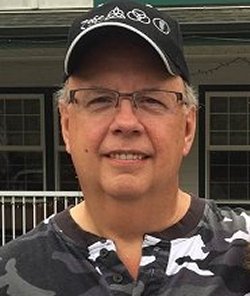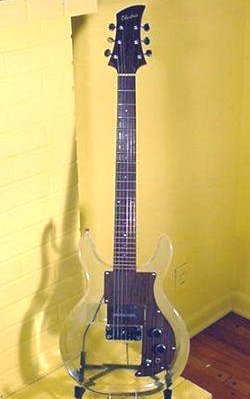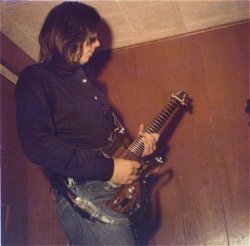

Mark Schnoor at the Crow's Nest - Camano Island 2019
|
 To the Dan Armstrong Web Site
To the Dan Armstrong Web Site |
For those who have visited this site before, I hope you find this update enjoyable. While much of the content is the same, nearly every section has new &/or updated
information within. After 20 years this is most likely my last update but if something new comes my way I will add it but that would likely be all. Over the years I've
been very fortunate to have met, and made friends with others who knew Dan and it is with their help that I am able to tell even more of his story and I wish to thank
them for sharing their memories. Lastly, I would be remiss if I didn't thank my wife who's also been invariably helpful. But, then, she always is.
For new visitors to this site you can learn a bit about me by reading my story below - which has also been updated.
"It's been a long road - getting from there to here" sang Russell Watson in the opening credits to the
television series Enterprise. It was enough to break my concentration one day when it came on TV
while I was working on this update. The words rang through my mind and apparently struck a chord
in me for it was at that moment that it dawned on me how hard I have worked, how much I have learned through my
interviews, and how far I have come since I first decided to host this site back in 2001.
Unlike the Enterprise television series however, this site deals not in science fiction - but in non-fiction. It's emphasis is not about
the future nor the exploration of outer space, but rather the past - and the exploration of inner space for its
emphasis is on the journey of the life of Dan Armstrong and the products he designed which has enriched all our lives.
The roots of this site go back to 1970 when as a teenager growing up in the Midwest I received a musical catalogue in
the mail that featured something so unusual, so cool, and so electric that it made me forget about every other guitar
I had ever seen. There in the middle of the catalogue, as well as in the middle of one of the pages, was a photograph
of a Dan Armstrong · Ampeg clear guitar and bass. Looking back, I must have gazed upon that
catalogue, and that particular photograph for hours.

|
Unfortunately the price tag for such an instrument was out of my reach, and so I kept on playing the guitar I had. Eventually I raised
enough money to acquire a copy of the Dan Armstrong · Ampeg guitar much like the Electra instrument
seen at left only mine was a Ventura model - though from what I could tell, with the exception of the name on the headstocks
the two brands looked the same to me - then and now.
My friend (Hi Elon) and I did alot of recording of our own material as he designed his own recording/sound boards and
had several high quality tape recorders at his disposal, for his father ran an electronics shop - which also explains
where he learned his designing skills for making recording boards. To this day, I still think he had a soldering iron,
a roll of solder and a circuit board or two in his crib as a baby.
I had alot of fun with that Ventura copy, although I think I saw Elon grind his teeth a few times when I would
get up on the 24th fret and bend the string, making the note even higher and often times pegging the Vu
meters on his tape decks and other units. The concept of having two full octaves at my disposal opened up a whole new
dimension of sound for me and ultimately altered my playing style.
|

|
As seen at left, a year or so later I had acquired a real Dan Armstrong · Ampeg clear guitar by
trading a guy my 1972 Gibson SG and a few other musical items.
After the swap I immediately noticed that this guitar featured
a pickup unlike any I had seen in the catalogue. I remember thinking how funky it looked with its two rows of metal squares going
across it. I did like how it sounded though, and even more I liked the lack of virtually any hum given the distortion units I was
using at the time. I also noticed that a section of the tailpiece was sandblasted, which was also something I had not seen in the
catalogue that I had stared so long at.
|
Resting on that sandblasted tailpiece was a rosewood bridge. This too, looked nothing like what was in the music
catalogue, as it had a fret placed across it. If that weren't enough, I also noticed that the tuners were different.
The catalogue showed these instruments with Schaller tuners whereas my guitar was equipped with a set
of Grover Rotomatic tuners. This was a small matter however, as both brands of tuners were excellent,
but together with all the other differences it made me wonder if I was the recipient of a modified guitar, though if
it was, it had to have cost a fortune, as it was very well done.
Last, but not least, I noticed that the guitar was missing the thumbscrew that secured the pickup to the acrylic body
and I realized in my haste to acquire this instrument, I wasn't watching close enough. It was 1974 and in his attempt
to sweeten his side of the deal, the guy I did the swap with informed me that Ampeg was no longer making the clear
guitars and basses, as they stopped production in 1971 and the instruments were now getting somewhat collectible.
With Ampeg no longer making these instruments, I knew it was a shot in the dark - but I nevertheless sent off a
letter to them explaining that I had just gotten a clear guitar and was in need of a pickup screw as well as the
other 'two' types of rosewood bridges - for my guitar only came with one bridge, and the catalogue had printed that
these guitars came with a low, medium and high type bridge and I would like to have them all.
To their credit, Ampeg responded - stating that these instruments were no longer being manufactured, but they did send
me a pickup screw with their letter as a courtesy. They also stated that while the instruments were no longer being made,
the rosewood bridges could be ordered, though I forget what they cost. Needless to say I ordered all the extra bridges.
One day Elon also acquired a Dan Armstrong · Ampeg instrument - a bass guitar, and as we
jammed and did recordings with them, we often talked about how cool it would be to meet Dan Armstrong and talk with
him about these instruments. It was the kind of talk you would expect of a couple of teenage guys playing their clear
instruments. Lots of questions and plenty of dreams.
Above left, a photo of me sitting on the couch in Elon's basement playing my Dan Armstrong clear guitar, while Elon
stands playing the bass. Barely visible off to the right of him rests one of his first homemade instruments where he took a
Danelectro neck with Kluson tuners and put it on a homemade Rickenbacker 4001 style guitar body made of mahogany that features
Gibson hardware, including an ABR-1 bridge and original early 1960's Patent-Sticker humbuckers. It played pretty good
and I sometimes used it when I was multi-tracking a lead solo.
At upper right, I one day asked Elon to just start playing as I was looking for just the right shot to take of both
him, and his Dan Armstrong bass. Notice the late 1960's style chair behind him. Elon had owned several bass instruments
over the years, and to this day what I remember the most about his Dan Armstrong bass when compared to others he had
owned was that it had such a good, thick, solid, yet tight low end to it, while at the same time preserving a smooth
sounding midrange and upper high end tone.
At upper left, an underside shot of one of Elon's home made recording/sound boards with parts sprawled out over his
work bench (which was actually his bed). At upper right, and a few years later I used my Dan Armstrong guitar in a
local garage band. As seen here after a sound check - our drummer can be seen kneeling by the floor toms talking to
his girlfriend who is seated at his drum set. My Dan Armstrong clear guitar can barely be seen resting in a guitar
stand at the far right in the photo, while our bass players original black Dan Armstrong bass can be seen at the far
left.
Soon Elon & I ran across another Dan Armstrong · Ampeg guitar, though this one was quite
unlike any that we had seen before. Although the body was the same, we immediately noticed that this model had a
scratchplate that featured a different texture to it than ours. Although it featured the same artificial wood grain
type look to it we noticed that it had a smooth, glossy type texture to it - whereas our scratchplates had a
matte type finish to them that, in comparison, looked somewhat dull, with no shine to it at all. The tuners on the neck
were Schallers instead of the Grovers like our Dan Armstrong's had, and the tailpiece was not sandblasted, it was all
chrome. We then noticed that the rosewood bridge had no fret across it, which wasn't quite such a shock, for Elon's bass also had an all
chrome tailpiece with no sandblasting - as well as a rosewood bridge without a fret. However, we were both quite
amazed when we discovered the size of the maple neck on this guitar. It was much bigger, or thicker than the necks on
our instruments.
Given the various different features this guitar had compared to ours made me dig out my old catalogue once
again. It was amazing that I still had it, and after looking through it once again and refreshing
my memory, it was with a bit of pain, a modest amount of humility, and a whole lot of confusion that I noticed this
particular instrument, with it's shiny scratchplate and Schaller tuners- looked exactly like what was in the catalogue.
Now I really had some questions.
Unfortunately, there was just nowhere to turn for answers. A few more years went by and any questions I
had about these instruments were left unanswered. As time passed I just learned to accept things as they were. I was
still curious, mind you, but with nowhere to turn I just let it all go and pretty much put everything on the
back burner.
After several more years Elon had moved to the West Coast. I remained in the Midwest and continued to play in a local
rock band. Today we are both still involved in music as I still play in a band, while Elon eventually relocated to
Meridian, MS - where his talents were put to good use working as a senior sound mixer designer for Peavey Electronics
until his retirement. Today he enjoys making guitars in his free time.
continue
menu
Names and images are TMand © Dan Armstrong / Ampeg. All rights reserved.
All other names and images are TMand © of their respective owners. All rights reserved.
|
| |

